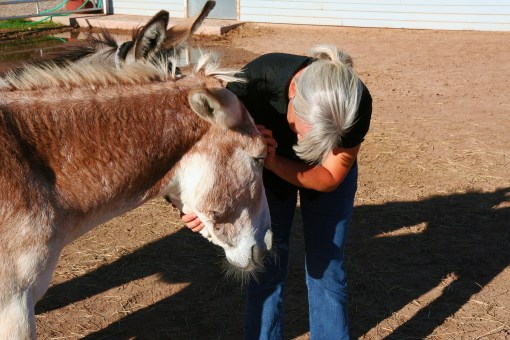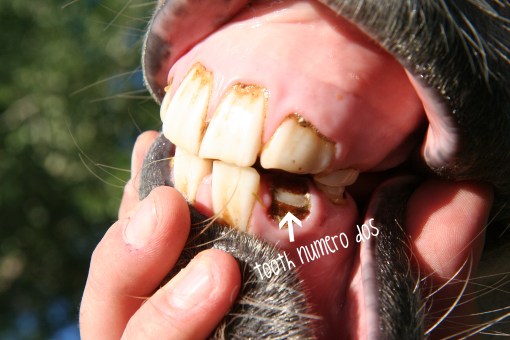Early Monday morning, I looked out the window to see Ellsworth doing his mouth thing again. Because it was early and it was cool out, flies weren’t yet an issue. I’m not sure what prompted me to look in his mouth again, but when I did, a couple of his lower incisors didn’t look right. I also noticed an abnormal mouth odor, and Ellsworth just didn’t seem right. That’s when I decided to call the vet.
Our vet, Dr. D, paid us a visit yesterday afternoon. He’s awesome and we think he’s wonderful (thanks Carson!). He gave Ellsworth a complete once over… temperature normal, lung and gut sounds normal, everything okay.
Here’s what we learned about donkey teeth:
The baby teeth of a young donkey are replaced by the permanent teeth between the ages of 2 1/2 and 4 years. Donkey permanent teeth include:
- Three incisors on top and bottom on each side
- One canine on top and bottom of each side (males)
- Three premolars (four if wolf teeth are present) on top and bottom on each side
- Three molars on top and bottom of each side
Dr. D determined that two of Ellsworth’s baby incisors were very loose and ready to come out, which could be causing him discomfort, so we decided to go ahead and have them pulled. They came out very easily. You can see there wasn’t a whole lot of them left as they were quite worn down:
You can also see that Ellsworth’s permanent teeth are well on their way. These photos were taken after his baby teeth were pulled (and right after he had his evening portion of sweet feed).
We also decided to have Dr. D float Ellsworth’s teeth while he was here. For those of you not familiar with “floating teeth”, here’s an explanation from Donkeys: A Veterinary Guide for Owners and Breeders: Sharp points on cheek teeth may be resolved by a technique known as floating. A long-handled file is introduced into the mouth and rapidly moved in and out as it is angled diagonally to the tooth edges – this blunts and rounds the sharp points. (Sharp points may develop on the outside edges of the upper cheek teeth and/or inside of the lower cheek teeth. These points can irritate or cut the cheeks or tongue and cause the animal to be reluctant to chew food properly.)
Needless to say, because it was Don’s and my first time witnessing this procedure, it was a little painful for us to watch. (In case you’re wondering, Ellsworth was sedated, and we were very thankful for that.)
Of course, we’ll keep an eye on Ellsworth for the next few days to see if his odd behavior continues. Thanks to everyone who left comments on Friday’s post… we appreciate everything we learn from all of you. A lot. ♥





July 28, 2010 at 4:15 am
Boy, what a day for Ellsworth, but what a good boy to let you take pictures of his mouth for all of us to see. Hope he’s much happier now!
LikeLike
July 28, 2010 at 6:36 am
Pat,
Thanks. We really hope he is feeling much better. 🙂
LikeLike
July 28, 2010 at 5:01 am
Well, gee, I didn’t realize Ellsworth was still young enough to have his baby teefers! Imagine Nature habitually growing teeth in such a way that it would cause an animal not to be able to eat properly. Doesn’t seem right, does it?
LikeLike
July 28, 2010 at 6:39 am
June,
Funny you should mention that… The first time Dr. D met Ellsworth last September, Dr. D was quite surprised when we told him that Ellsworth was already meant to be four years old (according to Ellsworth’s previous people).
Mind you, Ellsworth wasn’t having any problems eating, he just appeared to be uncomfortable. Ellsworth LOVES to eat. 😀 In fact, Dr. D mentioned yesterday that we should probably start keeping an eye on Ellsworth’s weight, because once donkeys get fat, it’s quite difficult to get weight off them.
LikeLike
July 28, 2010 at 5:38 am
LOL LOL Glad to hear it was somthing normal !!
LikeLike
July 28, 2010 at 6:40 am
Mel,
Thanks! Fingers crossed that he continues to do better. 🙂
LikeLike
July 28, 2010 at 6:08 am
You did put those teeth under his pillow last night, I hope? Did Fergus and Nigel get a chance to meet Kevin? You know I need the full report.
LikeLike
July 28, 2010 at 6:10 am
Oh – and did you show him your new tattoo?
LikeLike
July 28, 2010 at 6:44 am
Carson,
Dang it! I swear that I didn’t even think about it until just now when you asked. Shoot!
LikeLike
July 28, 2010 at 6:43 am
Carson,
Well, actually, the teeth are still soaking in bleach. Let me tell ya, they were stinkin’ up the joint, which could be one of the reasons why Ellsworth was uncomfortable.
Everyone except for Nigel got an exam and vaccinations and Fergus did great. Kevin said that Bernard is perfect (woot-woot) and Fergus looks great. 😀 Kevin also took gifts from each of the boys… only one had worms – Bernard. So, following Kevin’s instructions, we gave Bernard some Ivermectin last night.
Nigel’s going to be in for quite the day of beauty when he comes around… hugs, mani-pedi, spa treatments galore! 😀
LikeLike
July 28, 2010 at 6:47 am
Maybe it’s the worms that make BerNERD such a goofball….
LikeLike
July 28, 2010 at 6:54 am
Nancy,
It was strange to me that Bernard was the only wormy one. Go figure. Then again, Bernard is always looking for ways to be unique. 🙂
LikeLike
July 28, 2010 at 6:14 am
So, he’s sort of the same age as a grade school child? Hope he doesn’t end up needing braces. LOL
Di
LikeLike
July 28, 2010 at 6:48 am
Di,
LOL, yup, I guess you could say that! Ellsworth is meant to turn five this year, but Dr. D thinks he’s probably closer to four based on his teeth. Have a good day, Di.
LikeLike
July 28, 2010 at 6:45 am
They’re just like our babies…. when they hurt and can’t tell us, we just have to figure it out… So glad you called the vet. You know there’s nothing worse than a toothache! At least not in my book..
LikeLike
July 28, 2010 at 6:50 am
Nancy,
Thanks. Agreed. I don’t know who felt better after Dr. D’s visit yesterday – Ellsworth or me. One of the wonderful things about Dr. D is that he takes so much time examining the boys and explaining everything to us.
LikeLike
July 28, 2010 at 6:51 am
Justina, I was just looking at “for the love of donkeys” page and I have a question. Is Ellsworth the same type of donkey as Linda’s? Their coloring is very similar, isn’t it?
LikeLike
July 28, 2010 at 7:01 am
Nancy,
We thought the same thing – their coloring is very similar. Linda’s Sam is a Mammoth, while Ellsworth is a large standard.
LikeLike
July 28, 2010 at 7:09 am
And I appreciate everything that I learn from you! Thanks for posting the update on Ellsworth. I’ll bet he feels MUCH better very soon. Sending hugs for him and the other boys ♥
LikeLike
July 28, 2010 at 7:11 am
Tammy,
Thank you. Hugs shall be delivered! ♥
LikeLike
July 28, 2010 at 7:27 am
What a long day for Ellsworth – thank goodness he had good drugs! I hope he is feeling better very soon. Thanks for the details, your post was interesting and informative. xo to all!
LikeLike
July 28, 2010 at 7:33 am
Oh, get well soon Ellsworth. I grew up with ten years worth of braces, so I know what it is like to have achy teeth. Hope the new ones come in straight and shiny.
I’ve seen tooth floating done on a horse. Good GRIEF! That is a terrible sound. I’m glad that Ellsworth was sedated.
Poor Bernard and his worms… Hope the medicines do their thing!
LikeLike
July 28, 2010 at 7:45 am
I’m so glad you had the vet out for Ellsworth. I had no idea he was that young! When one of our mares was young-I kept her baby teeth that I found in her stall. Washed em up good and still have em in a jar! LOL And please don’t let Ellsworth get too fat…my Russell is a porker! He was fat when we got him two years ago. We still haven’t gotten much weight off of him. He’s a mini-so it really shows. Don’t tell Russ I said this-but he looks preggers!
LikeLike
July 28, 2010 at 8:03 am
It pays to be observant, doesn’t it? Floating teeth is a yearly procedure here, you’d be surprised how quickly those sharp points and hooks can come back- it’s definitely not a once-in-a-lifetime deal.
LikeLike
July 28, 2010 at 8:43 am
Ah yes, the teeth floating procedure. Been there, done that numerous times.
I didn’t know Ellsworth was that young! He should be feeling great now that he has been to the dentist! 🙂
LikeLike
July 28, 2010 at 8:49 am
Awww. He’s such a sweet guy. I’m so glad you found out what he needed and that you have such a loving vet, too. It does my heart good to know that you are giving them such a loving home.
LikeLike
July 28, 2010 at 9:09 am
Glad to know the issue seems to have been one that is very easily resolved!
My second corgi, Sophie, had baby teeth that weren’t falling out before the permanent teeth came in. She was set to be spayed in a few days, and they were going to pull them, but I played some rough tug-of-war with her, and the teeth came out.
My daughter had the same problem with one of her canines. We bought her the stickiest candy we could find, told her to bite allll the way down and then yank her jaws open as hard as she could, and that did the trick. 🙂
Ellsworth would have loved that………… 🙂 🙂 🙂
LikeLike
July 28, 2010 at 9:58 am
It’s wonderfully comforting (and invaluable) to have a vet that you know is good with your donkeys, isn’t it?
I never thought I’d be so familiar with donkey sedation… did you go with the milder ACE or the “hard stuff” (IV controlled substances)? lol
Congrats on a successful first vet visit!
LikeLike
July 28, 2010 at 1:39 pm
No wonder flies were hanging around. A stinky set of teeth will draw them in quickly. I’m so glad that’s all it was. Thrilled also that he had a good vet visit.
It’s funny, all that gray hair makes me think he is an old man. 🙂
LikeLike
July 28, 2010 at 2:12 pm
Caring for animals seems to involve so much detective work, doesn’t it? Careful observation and a healthy dose of paranoia seems to work best.
So glad to hear my favourite fella is doing better.
LikeLike
July 29, 2010 at 5:59 am
Aww…he’s teething! Glad you got to the bottom of it! Now you’ll know what to watch for when his brothers go through it, too. 🙂
LikeLike
July 29, 2010 at 6:48 am
C,
Thanks! Welcome back. We’ve been thinking about you. 🙂
LikeLike
February 12, 2017 at 9:53 am
Thanks for this information! We just found a lost donkey and I’m trying to find out her age… Quite young I think, her teeth kind of look like the picture of you donkey! X
LikeLike